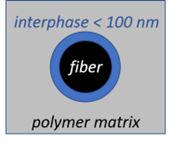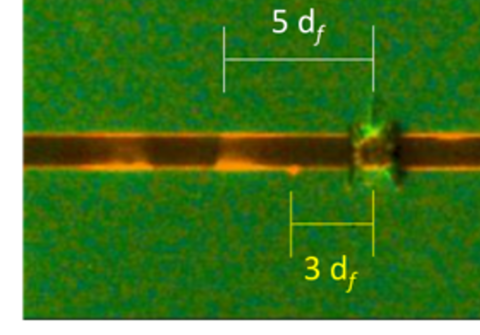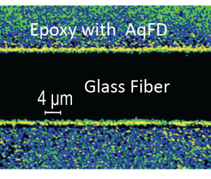Summary
The purpose of this project is to quantify the role that the fiber-matrix interphase plays in initiating and propagating damage in polymer matrix composites, thereby influencing their strength, toughness, durability, and overall mechanical performance under a range of environmental conditions that include temperature, humidity, and sub-catastrophic cyclic loading. This will be accomplished by developing advanced fluorescence imaging methods that, when coupled with novel fluorescent probe or reporter molecules, provides a microscopic platform to visualize damage initiation mechanism before catastrophic failure occurs. Applications include high performance structural composites (aerospace, automotive), civil and infrastructural composites (bridges, buildings, barriers), and biomedical composites (dental, scaffolds).
Description

Measurements of interphase properties are extremely challenging, and their effects on macroscopic properties and performance of composites are poorly quantified. The objectives of this project fall into the following four research thrusts:
- Fluorescence Based Probes to Sense Damage and Water in Composites: Design and synthesize dye molecules that can be incorporated into the matrix of a composite or the fiber interface of a composites that respond to events that include mechanical damage (mechanophores) and deleterious absorbed moisture (aquaphores). Develop fluorescence-based imaging strategies spatial resolve the local response of these probes in composite materials to understand where and why damage initiates. Calibrate the response of these dye molecules under controlled stress states or levels of hydration. Understand how the response of these probe molecules depends upon different types of polymer matrices and composite interphases.
- Interphase Properties in Cross-Linked Polymer Composites: A significant fraction polymer matrix composites a derived from cross-linked epoxy or acrylate matrices. Deploy these mechanophore and aquaphore probes into cross-linked network composites and combine with fluorescence imaging to aquaphores to perform in-situ mechanical deformation and hydration studies. Combine mechanophore studies with other quantitative mechanical tests to correlate response with properties like yield strength, fatigue strength, toughness, and interfacial shear strength. Combine aquaphore studies with other techniques to quantify water transport and its effects on the interphase properties. Quantitatively explore if confinement effects and dynamics in interphase affect the fluorescent emissions of the dye molecules.
- Interphase Properties in Tough Linear Thermoplastic Composites: There is a significant interest in the composites community to move away from cross-linked networks that are difficult to recycle and switch to linear thermoplastic matrices that can be readily melt processed and reprocessed. Develop mechanophores into polycarbonate-based thermoplastic composites. Combine mechanophores studies with other quantitative mechanical tests to correlate response with properties like yield strength, fatigue strength, toughness, and interfacial shear strength. Quantitatively explore if confinement effects and dynamics in interphase affect the fluorescent emissions of the dye molecules. Develop molecular dynamics models of the polycarbonate interphase and attempt to correlate dynamic changes in the interphase with fluorescence lifetime changes and resulting changes in the mechanical property.
- Origins of Toughness in Biologically Inspired Composite Materials: Mother Nature has perfected the art of making composite materials that integrate both strength and toughness. Naturally occurring structures such as seashell nacre, the exoskeletons of sea creatures and insects, and even our own teeth and bone, are able to simultaneously maximize stiffness, strength, and toughness in ways that man-made composites cannot; there is usually a tradeoff between strength and toughness in man-made composites. While the primary object of this project is to provide measurements that lead to improvements in the man-made composites for engineering applications, a small fraction of our efforts will be used to leverage the tools developed above to determine what we can learn about the composite interphase, between the soft organic component and the stiff crystalline or mineralized filler, in composites that mimic those made by mother nature.


Testimony Before Congress
On April 8, 2018, Joannie Chin, deputy director of NIST's Engineering Lab, testified before the House Committee on Science, Space, and Technology, Subcommittee on Research and Technology on "Composite Materials – Strengthening Infrastructure Development," along with witnesses from academia and industry. The testimony contains background on NIST's deep expertise in composite measurement science and describes our roadmapping efforts in collaboration with members of industry, academia, and departments of transportation at federal and state levels.

